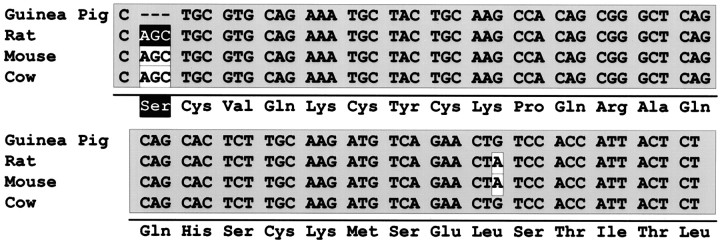Fig. 6.
The alternatively spliced PAC1 receptor isoform containing one cassette in the third cytoplasmic loop represents the HOP2 variant. The guinea pig PACAP-selective receptor 384 base pair product amplified using the PACAPR1 and PACAPR2 primers (see Fig. 4) was isolated and subcloned for automated fluorescence dideoxy dye terminator sequencing. All of the clones represented the HOP variant shortened at the alternative splice junction, consistent with the expression of the HOP2 form reported in rat (Spengler et al., 1993). The base sequence for the guinea pig (cavia parcillus) HOP2 cassette is aligned with the HOP1 sequences reported for the corresponding regions of the rat [rattus norvegicus;Spengler et al. (1993); GenBank Z23275 and Z23274], mouse [mus musculus; Hashimoto et al. (1996); GenBank D82935], and cow (bos taurus; Miyamoto et al. (1994); GenBank D17290]). Nucleotides differing from the guinea pig sequence are inwhite; regions of identity are shaded with gray. The three nucleotides deleted from the HOP2 isoform encoding a serine residue in the HOP1 variant of the rat, produced by alternative usage of contiguous splice acceptor site, are shaded with black. The predicted amino acid residues for the HOP PACAP receptor variant are shown below the nucleotide sequences. The one-base substitution is degenerate and conserves the leucine residue.

